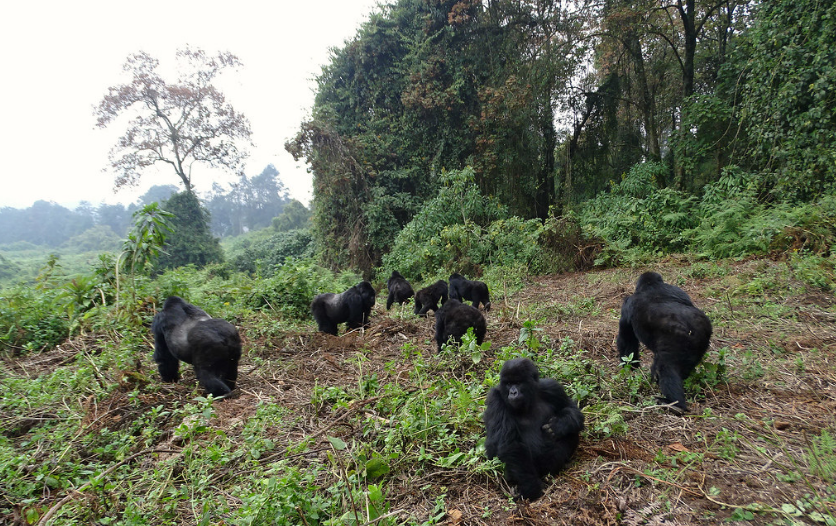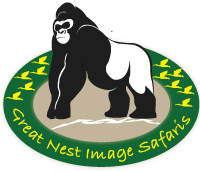Volcanoes National Park is found in northwestern Rwanda. It covers 160km2 of rain forest and encompasses five of the eight volcanoes in the Virunga Mountains, namely Karisimbi, Bisoke, Muhabura, Gahinga and Sabyinyo. The park was first gazette in 1925 as a small area bounded by Karisimbi Bisoke and Mikenoi, intended to protect the gorillas from poachers and it was the very first National Park to be created in Africa. Subsequently, in 1929, the borders of the park were extended further into Rwanda and into the Belgian Congo, to form the Albert National Park, a huge area of 8090km2 run by the Belgian colonial authorities who were in charge of both colonies. In 1958, 700 hectares of the park were cleared for a human settlement. The park later became the base for the American naturalist Dian Fossey to carry out her research into the gorillas. She arrived in 1967 and set up the Karisoke Research Centre between Karisimbi and Visoke. From then on she spent most of her time in the park and is widely credited with saving the gorillas from extinction by bringing their plight to the attention of the unknown assailants at her home in 1985, a crime often attributed to the poachers she had spent her life fighting against. Fossey’s life later was portrayed on the big screen in the film Gorillas in the mist, named after her autobiography. She is buried in the park in a grave close to the research center, and amongst the gorillas which became her life.

Flora: Vegetation varies considerably due to the large attitudinal range within the park. There is some lower montane forest (now mainly lost to agriculture). The bamboo forest occurs, covering about 30% of the park area. Secondary thicket, meadows, marshes, swamps and small lakes also occur, but their total area is relatively small.
Fauna: This park is best known for the mountain gorilla (Gorilla beringei beringei). Other mammals include: golden monkey (Cercopithecus mitis kandti), buffalo (Syncerus caffer), spotted hyena (Crocuta crocuta) and bushbuck (Tragelaphus scriptus). There are also reported to be some elephants in the park, though these are now very rare. The park has over 178 recorded bird species, with at least 13 species and 16 subspecies endemic to the Virunga and Rwenzori Mountains.
Major things to do in Volcanoes National Park
For the nature enthusiasts, the Volcanoes national park is a true paradise filled with lush green forest, rare mountain vegetation, crater lakes, plenty of wildlife such as forest elephants and buffaloes, golden monkeys and mountain gorillas, endemic birds of the Albertine rift, breathtaking views of Rwanda’s mist shrouded mountainous landscape and sprawling volcanoes. They offer an unrivaled African jungle experience and one of the best scenery on the African continent!
Climbing of Bisoke volcano
Bisoke like all the peaks in the Virunga Mountain Range, is a volcano created by rifty action on the forming divergent boundary of the East African Rift which is slowly bisecting the African plate. Being within two national parks, it is by law off-limits to most standard wilderness industries such as logging, farming, or mining. Aside from visitors to the parks searching for gorillas or other wildlife, the peak is popular with mountaineers. It can be climbed in a day from the Rwandan side, and the Rwanda Development Board (RDB) leads two-day excursions to it and nearby Mount Karisimbi, most often out of the nearby city of Ruhengeri. The climb is considered steep but walkable.
Hiking Mountain Bisoke Crater Lake
Bisoke is a dominant Volcano rising at 3711 meters above sea level. The mountains is one of the series of volcanoes that make up the Virunga Mountain Ranges which sprawls along the borders of Rwanda, Uganda & the Democratic Republic of Congo. Bisoke hiking is popular among visitors to the Volcanoes National park in Rwanda because of the possibility of viewing the fog filled summit, crater lakes.
Climbing of Karisimbi volcano
The name Karisimbi comes from the word ‘amasimbi’ in the local language, Kinyanrwanda, which means snow. Snow can mostly be found during the dry season in June, July and August on the top of the volcano. Karisimbi is the highest of the eight major mountains of the mountain range, which is a part of Albertine rift the western branch of the East African rift. Karisimbi is flanked by Mikeno to the north, Bisoke the east and Nyinagongo to the west, on the other side of the Rift Valley. This is a two-day trek with overnight camping at an altitude of 3,800m. Between Karisimbi and Bisoke is the Karisoke Research Center, which was founded by Dian Fossey order to observe the mountain gorillas living in this area.
Mount Gahinga
This is a dormant/extinct volcano in the Virunga Mountains on the border between Rwanda and Uganda. Gahinga lies between Muhabura and Sabyinyo, but is the smallest of these three. Mgahinga Gorilla National Park also got its name from this volcano. Mount Gahinga, whose elevation is 3,473 m, is part of a chain of eight volcanic mountains of the Mufumbiro ranges. The volcano chain spans across Uganda, Rwanda and the Democratic Republic of Congo. The vegetation across the mountain can be described as afro-montane with bamboo composing the main vegetation. Like Muhabura and Sabyinyo the bamboo forests on Mount Gahinga are a habitat of the endangered mountain gorilla. There are several other species of animals and birds that form part of the Mount Gahinga ecosystem and golden monkeys are notable to these.
Musanze Caves
The largest district with in the northern province of Rwanda and its capital Ruhengeri is known as Musanze and it also serves as a center for tourism in Rwanda and its where Volcanoes National park is situated. On the outer side of Ruhengeri are also the Musanze caves and are a geological treat. Musanze caves were officially recognized as tourism products in Rwanda in 2013 and have since then become a must visit in Rwanda for a complete safari package. These four caves, 2km from the town centre along the road to Gisenyi, were created when different lava flows joined to create the Albertine Rift Valley. Musanze caves are surely worth visiting! For the most exceptional adventures of lifetime besides engaging in mountain gorilla trekking experience, visit Musanze caves in Volcanoes National.
Visiting the tomb of Dian Fossey
Dian Fossey was a zoologist best known for researching the endangered gorillas of the Rwandan mountain forest from the 1960s to the 1980s. She was born on January 16, 1932 in a country called San Francisco, California, and grew up with her mother and stepfather. Developing an affinity for animals at a young age, throughout her youth, Fossey was an avid horseback rider and an aspiring veterinarian. However, after enrolling in pre-veterinary studies at the University of California, Davis, she transferred to San Jose State College and changed her major to occupational therapy. After graduating from San Jose in 1954, Fossey spent several months working as a hospital intern in California and then moved to Louisville, Kentucky, where she began serving as director of the Kosair Crippled Children’s Hospital’s occupational therapy department in 1955. Living on a farm on the outskirts of Louisville, Fossey spent many off-hours happily tending to the livestock. But her contentment didn’t last long. She soon became restless, longing to see other parts of the world and setting her sights on Africa.
Considered the world’s leading authority on the physiology and behavior of mountain gorillas, Fossey fought hard to protect these “gentle giants” from environmental and human hazards. She saw these animals as dignified, highly social creatures with individual personalities and strong family relationships. Her active conservationist stand to save these animals from game wardens, zoo poachers, and government officials who wanted to convert gorilla habitats to farmland caused her to fight for the gorillas not only via the media, but also by destroying poachers’ dogs and traps. Tragically, on December 26, 1985, Fossey was found hacked to death, presumably by poachers, at her Rwandan forest camp. No assailant has ever been found or prosecuted in her murder. Fossey is buried at Karisoke, in a site that she herself had constructed for her deceased gorilla friends. She was buried in the gorilla graveyard next to Digit, and near many gorillas killed by poachers.
Kwita Izina
This is a ceremony of naming baby gorillas, it takes place every year on the 1st of September. Do not forget to book with us and have a chance to attend special events like these plus much more.
Where to Stay In Volcanoes National Park
The park has got a lot of lodges, camps & hotels for accommodation ranging from luxury, budget and mid-range and these are available both inside and outside the park. You can book your accommodation through our company and early bookings are advised.
Luxury
- Gorilla Village
- Mountain Gorilla View Lodge
Moderate
- Gorillas Volcanoes Hotel,
- Musanze Caves Hotel
Budget
- Red Rocks Rwanda,
- Rohondo Beach Resort






